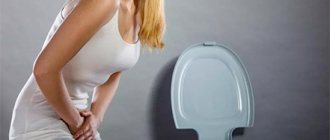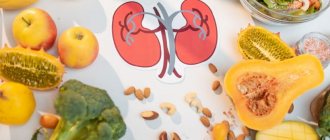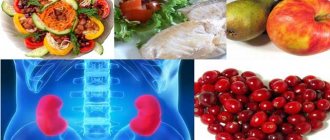Basic rules of the oxalate diet
Oxalate stones are dark or light brown spiky stones consisting of calcium oxalate and ethanedioic acid crystals. The key reason for stone formation is a violation of the metabolism of mineral and organic substances. To restore metabolism, you need to adhere to a hypooxalate diet, which has several goals:
- prevention of re-deposition of stones;
- shift in urine pH to the alkaline side;
- decreased production of ethanedioic acid;
- correction of the functioning of the kidneys and gastrointestinal tract.
Following the rules of the diet stimulates the dissolution of stones and prevents exacerbations of oxalate urolithiasis (urolithiasis).
Diet
The diet for oxaluria involves eating 4-5 times a day. To reduce the load on the gastrointestinal tract and urinary system, you should:
- eat small portions;
- take equal intervals between meals;
- eat food warm;
- Do a fasting day once a week;
- give up alcoholic drinks.
Obese patients must adhere to a strict diet. Fasting and overeating leads to an increase in the content of uric and ethanedioic acid, which creates conditions for the formation of calcium oxalate stones.
It is advisable to take your last meal 2.5-3 hours before bedtime. Eating food at night increases the load on the gastrointestinal tract, which can lead to constipation and metabolic disorders.
Volume and quality of drinks
As part of the diet, it is recommended to consume up to 2.5-3 liters per day. Increased urine output gives positive results:
- decreased concentration of acids in urine;
- reducing the rate of stone deposition;
- leaching of acid esters and salts from the urinary ducts.
For oxalate stones, slightly alkaline mineral water is indicated:
- Morshynskaya;
- Naftusya;
- Semigorskaya;
- Berezovskaya;
- Mirgorodskaya;
- Dilijan;
- Essentuki No. 4;
- Luzhanskaya.
The diet prohibits the consumption of sodium chloride (table salt), which retains fluid in the tissues. Urologists advise alternating mineral water with:
- decoctions of vegetables;
- kidney tea;
- dried fruit compotes;
- fruit teas;
- lingonberry juice.
Drinks contain organic acids - formic, malic, benzoic - which dissolve stones.
Normalization of blood pH
Nutrition for oxalate kidney stones is aimed at normalizing the acid-base balance. The level of bases and acids in the blood is partly regulated by the kidneys, which excrete excess of these substances in the urine.
With oxalate stones, the blood pH will shift towards the acidic side - below 7.35.
To restore the acid-base balance and eliminate stones, it is necessary to limit the following in your diet:
- refined oils;
- easily digestible carbohydrates;
- table salt;
- granulated sugar;
- rich broths;
- grilled meat.
If you have mineral stones, avoid products with ascorbic and ethanedioic acid. They acidify the urine, which leads to increased stone formation in the kidneys.
Reducing the load on the kidneys
Traditionally, in the treatment of urolithiasis, diet No. 5 according to Pevzner is followed. But nutritional features largely depend on:
- associated complications;
- composition and diameter of stones;
- causes of stone formation.
To reduce the load on the urinary system and avoid new stones, exclude foods from the diet that:
- irritate the urinary tract;
- retain fluid in tissues;
- contain ethanedioic acid.
The diet recommends eating more fruits and vegetables, which have diuretic properties. They stimulate urine formation and help flush out ethanedioic acid crystals and harmful bacteria from the urinary system.
Cooking methods
If you have oxalate stones, it is not advisable to fry fish, meat or vegetables. To stimulate the functions of the urinary system and gastrointestinal tract, products are boiled. During cooking, up to 60% of extractive substances that irritate the mucous membrane of the urinary tract are removed from vegetables, meat and mushrooms.
As part of the diet, meat is included in the menu no more than 3-4 times a week. To quickly restore kidney function, diet therapy is followed for at least 2-3 months in a row. To diversify the diet, it is allowed to bake fruits, lean fish, cottage cheese, and vegetables from time to time.
Fully or partially limited products
A large amount of oxalic acid is typical for products of plant origin, therefore, in case of oxalate kidney stones, greens, vegetables and fruits with a salt content of more than 0.3 g per 1 kg of product are prohibited.
Table of prohibited products
The table lists foods that are characterized by high and moderate levels of oxalic acid.
| Category | Name |
| Vegetables | Onions, broccoli, Brussels sprouts, red cabbage, green leafy vegetables, rutabaga, olives, corn, beets, turnips, tomatoes, peas, celery, beans, sweet potatoes, radishes, peppers, chickpeas. |
| Fruits and berries | Citrus fruits, kiwi, figs, all types of currants, persimmons, gooseberries, strawberries, mango, coconut, wine berries. |
| By-products | Liver, brains, kidneys, tongue. |
| Meat and fish | Canned food, pate, caviar, smoked meats, boiled milk sausages. |
| Greenery | Parsley, spinach, sorrel, lettuce, rhubarb, nettle, rosemary, sage. |
| Nuts and seeds | Peanuts, cashews, sesame seeds, poppy seeds, pecans, chia and sunflower seeds, flax seeds, almonds, soybeans, pistachios. |
The menu for the week does not include sweets and meat broths. Products containing gelatin are prohibited, since the glycol in its composition activates the production of oxalic acid.
There are foods that are included in the daily diet in limited quantities. Partial restrictions apply to the following products:
- salt - about 2 g per day;
- sugar and honey - 1 tbsp. l. in a day;
- eggs - 1 yolk;
- cottage cheese - 400 g;
- lard - up to 30 g;
- vegetable and butter - 60 g.
In this diet, meat and fish are considered interchangeable, so they alternate in the menu. You should not consume more than 150-200 g of the product once every 2 days.
Nutrition for oxalate stones
Foods that are allowed for oxalates
The diet should include fruits and vegetables, which alkalize urine. For oxalates, foods with:
- folic acid;
- pyridoxine;
- retinol;
- magnesium
Bioactive substances accelerate kidney healing, restore metabolism and acid-base balance. When following a diet, decoctions of herbs are recommended - bearberry, sage. To enhance intestinal motility and prevent stones, increase the consumption of plant fiber.
List of Hypooxalate Diet Foods
| Product groups | Examples |
| fermented milk | drinking yogurt, milk, hard cheese, sour cream, fermented baked milk, kefir, cottage cheese |
| greens, vegetables | cilantro, Brussels sprouts, squash, broccoli, pumpkin, eggplant, carrots, cucumbers, potatoes |
| fruits, berries | melon, peaches, grapes, pears, quince, sweet apples, apricots, watermelon |
| nuts, dried fruits | raisins, dried apricots, dates, prunes |
| flour products | pasta, wheat bread |
| porridge, cereals | pearl barley, bulgur, millet, oatmeal, buckwheat |
| meat products | turkey, rabbit, chicken (without skin), beef, veal |
| fish, seafood | cod, pollock, mullet, pike, hake, pollock |
| beverages | slightly alkaline water, apricot compote, cucumber juice, weak tea, bearberry decoction, dried apricot jelly |
| other | marmalade, butter, honey, fruit jam, vegetable sauces |
The diet recommends soups prepared with vegetables and cereals in water.
The basis of nutrition for stones in the urinary ducts are boiled vegetables, baked fruits, porridge with water, and fermented milk products. During periods of relapse of urolithiasis, the diet is followed for 2-3 weeks in a row.
What to eat to dissolve oxalate kidney stones
It is impossible to dissolve mineral stones with products. But proper nutrition restores the pH of urine, which prevents further stone formation. Therefore, the diet includes products with the following important components:
- pyridoxine – rice flour, oregano, mint, corn, millet, flax seeds;
- retinol – carrots, chicken eggs, fish oil, baked zucchini, apricots, dried apricots;
- magnesium – pine nuts, hazelnuts, rice, pearl barley, sesame seeds, sunflower seeds.
Pyridoxine and magnesium accelerate the excretion of ethanedioic acid. Due to this, the risk of stone formation in the renal pelvis is reduced.
When following a diet, special attention is paid to folk remedies. To restore metabolism, you need to use decoctions of the following herbs:
- Linden;
- peppermint;
- elderberry inflorescences;
- violet roots;
- bearberry;
- Birch buds;
- nettle.
Every day, between main meals, drink 150-250 ml of decoction. For oxalate stones, diuretic herbs are no less effective - juniper, bird knotweed, horsetail.
Decoctions of diuretic action are used only in the absence of concomitant diseases - ureteral obstruction, renal failure, obstructive urethritis.
Indications
Calcium oxalates are present in any body, but their concentration indicates disturbances in the functioning of the kidneys. An oxalate diet is the main way to get rid of stones. They sit on it when the following symptoms appear:
- frequent urination;
- constant pain in the lower back, lateral abdominal area, groin;
- dark yellow or reddish urine;
- an increase in the number of leukocytes or protein in the urine;
- increased temperature due to inflammation in the kidneys;
- fatigue.
Mineral water removes stones from the ureter. The liquid containing fluorine, tungsten and silicon normalizes mineral metabolism and eliminates pain. Its use in combination with a balanced diet enhances the dissolution of oxalates.
Diet for oxalate stones
Oxalic acid in products: what is prohibited
The diet for mineral stones excludes foods with ethanedioic acid. Therefore, pickles, marinades, smoked meats, rich broths, canned meat, and dried fish are removed from the menu. To avoid the formation of stones in the urinary system, limit fruits with vitamin C - gooseberries, all citrus fruits, sour apples. According to diet No. 5, reduce the consumption of table salt to 3 g/day.
What not to eat if you have calcium oxalate stones
| Product groups | Examples |
| fermented milk | suluguni, fat sour cream and cottage cheese |
| greens, vegetables | celery, salad pepper, horseradish, sauerkraut, spinach, radish, canned cucumbers, tomatoes, sorrel |
| fruits, berries | raspberries, lemons, grapefruits, pomegranate, currants, strawberries, tangerines, gooseberries |
| nuts, dried fruits | cashews, walnuts |
| confectionery | pastries, chocolates, cakes |
| sauces, oils and fats | ketchup, mustard, cooking oil, refined oil, margarine, mayonnaise, adjika |
| meat products | pork, dried meat, sausage, goose, sausages, smoked chicken, bacon |
| fish, seafood | red and black caviar, cod liver, canned fish, silver carp, sturgeon, salmon |
| beverages | alcohol, cocoa, strong tea, carbonated drinks, natural coffee, citrus juices, hot chocolate |
| other products | lard, offal, marmalade, corned beef, mushrooms |
To prevent stones in the renal pelvis, dishes with gelatin are removed from the diet.
Strong herbal teas disrupt phosphorus-calcium metabolism, so they are completely excluded.
If urolithiasis is diagnosed, it is undesirable to consume prohibited foods even outside of exacerbations. Neglect of diet is dangerous due to the deposition of stones in the urinary ducts, bladder, and urethral canal.
Features of the diet for oxaluria in children
The urinary system of children under 12-14 years of age is physiologically immature. It is not able to maintain acid salts in dissolved form. Therefore, an increase in oxalates in urine is fraught with stones. In 55-60% of cases, oxaluria occurs due to poor nutrition, abuse of fast food, carbonated drinks, and sour fruits.
A diet for oxalates in the urine of a child is aimed at restoring the metabolism of organic and mineral substances. A developing organism needs a continuous supply of proteins, carbohydrates and lipids from food. Therefore, the hypooxalate diet in children has significant differences from the diet in adults:
- Only foods high in ethanedioic acid are excluded from the diet;
- increase the consumption of dairy products - low-fat cottage cheese, fermented baked milk, drinking yogurt;
- The basis of the diet should be dietary soups and vegetable side dishes.
In case of calcium oxalate stones, special attention is paid to the drinking regime. The daily fluid volume is increased by 50% of the physiological norm. It is advisable to drink 200-250 ml of slightly alkaline water 20-30 minutes before meals.
What are "oxalates"
The term denotes salts of an acid (oxalic). The substances enter the human body with some plant products. Their formation is also possible as a result of biochemical reactions.
Oxalates are distinguished by their hard consistency and the presence of spikes (bumps) on the surface. The sharp edges of natural substances cause damage to surrounding tissues and irritation, which leads to pain.
An increase in oxalate levels increases the risk of kidney pathologies and the development of stone disease. Scientists suggest that high concentrations of oxalic acid salts provoke autism and damage to organelles (cell mitochondria). Their dysfunction provokes:
- fibromyalgia;
- pain;
- inflammatory processes;
- disturbances in the functioning of the immune and nervous systems.
Important!
Often, high levels of oxalates are indicated by pain in muscles, joints, and eyes. Increased fatigue is often observed. The following reasons are cited that explain the excessive saturation of the body with oxalic acid salts:
- a genetic factor consisting in the mutation of certain genes;
- abuse of certain foods (citrus fruits, carbonated drinks, green vegetables);
- decreased activity of healthy intestinal microflora;
- hypervitaminosis C, B6 deficiency;
- disruption of the transport of oxalate ions across membranes.
When are oxalates harmful?
Salts of oxalic acid can have adverse effects on the body. Typically, a negative effect is observed with excessive concentrations of oxalates. Substances cause exacerbation of certain pathologies, for example, gout, rheumatoid arthritis.
Important! To reduce the level of oxalates in the body, you should pay attention to foods that contain magnesium, zinc and B vitamins. Maintaining beneficial intestinal microflora and limiting fat intake is essential.
Sample menu for the week
A diet with oxalates in the kidneys has a beneficial effect on the functioning of the digestive system and prevents cardiovascular diseases. If you follow the doctor’s recommendations, your stool will normalize, your body weight will decrease, and your overall well-being will improve.
Failure to diet for stones in the urinary system leads to complications - renal colic, sluggish pyelonephritis, renal failure.
To increase the effectiveness of diet therapy, the menu includes a variety of dishes. This prevents vitamin and mineral deficiency, anemia and other undesirable effects. When following a diet, it is better to create a menu of healthy foods at least 4-7 days in advance.
Sample diet menu for oxaluria
| Days of the week | 1 breakfast | 2 breakfast | Dinner | Afternoon snack | Dinner |
| Monday | muesli with milk, toast bread with butter, tea | carrot pancakes, tea | dietary soup, boiled beef, jelly | drinking yogurt | casserole with zucchini, carrots and hake, juice |
| Tuesday | egg white omelette, toast with jam, tea | baked pear with honey | cabbage soup without meat, boiled chicken, vegetables, compote | cottage cheese casserole, kefir | noodle soup, mashed fish cutlets, compote |
| Wednesday | oatmeal, drinking yogurt | 2 wedges of melon | baked pollock, broccoli soup, vegetable salad, herbal decoction | 100 g dates, kefir | diet soup, stewed cabbage, tea |
| Thursday | cottage cheese with dried apricots, compote | fruit salad, juice | soup with barley and potatoes, boiled veal, sliced vegetables, jelly | cucumber and carrot salad | chicken soufflé, vegetable stew, tea |
| Friday | cottage cheese with dried fruits, weak coffee | 100 g raisins, vegetable juice | lean borscht, vinaigrette, boiled fish, tea | oatmeal with dates | vinaigrette, carrot pancakes, tea |
| Saturday | muesli with milk, sweet apple | rye bread with jam, tea | noodle soup with meatballs, vegetable salad, herbal tea | 100 g raisins | cream soup with potatoes and broccoli, meat soufflé, tea |
| Sunday | buckwheat, toast bread with jam, drinking yoghurt | cottage cheese with dried apricots | vegetarian borscht, baked fish with boiled green beans, lingonberry juice | pumpkin casserole, compote | millet soup, cutlets, stewed cabbage, tea |
During periods of relapse of urolithiasis, it is better to abandon cereals and cereals in favor of boiled meat and vegetables.
We prepare dishes from permitted products
The diet for oxalaturia prohibits many foods, so it is difficult to follow. To reduce the likelihood of refusing medical nutrition, it is recommended to include new dietary, but tasty dishes in the diet:
- Zrazy with chicken. 250 g of chicken is passed through a meat grinder along with 15 g of rice. The minced meat is divided into 2 equal halves, rolling them into pancakes. Between them place 15 g of boiled rice, 1 chopped egg and a little grated cheese. The edges of the pancakes are connected and then rolled into a roll. Bake in the oven for at least 25 minutes.
- Soup with kefir and carrots. 4 carrots are peeled and chopped on a coarse grater. Pour ½ liter of fresh kefir and add 15-20 ml of liquid honey. If desired, decorate the dish with peppermint leaves.
- Vegetarian cabbage soup. Finely chop 1 onion and 2 medium-sized carrots and simmer in a frying pan with a small amount of water for 5-7 minutes. Add 1-2 tbsp. l. tomato paste. Place shredded cabbage and stewed carrots and onions into a pan of boiling water. Cook the cabbage soup until tender for 10-15 minutes.
- Fruit jelly. Boil 100 g of chopped apricots in ½ liter of water for 20 minutes. The broth is drained, and the fruit is mashed, after which it is boiled again in ½ liter of water. Both broths are poured into one container, 120 g of granulated sugar, 45 g of starch and ½ liter of citric acid are added. Boil over low heat for another 5-7 minutes.
Calcium oxalate stones are a consequence of metabolic disorders and abuse of products with ethanedioic acid. Following a diet leads to normalization of urine pH, which prevents stone formation. In case of exacerbations of urolithiasis, diet therapy is followed for at least 3 weeks in a row.
Basics of a healthy diet
The diet for oxalate lithiasis must comply with the following rules:
- the drinking regime should be maximized to reduce the relative density of urinary fluid and quickly remove salt deposits;
- maximum limitation of the intake of components with food that contribute to the formation of oxalates and the active spread of urolithiasis;
- you should not overeat to avoid imbalance of metabolic processes;
- It is recommended to strictly adhere to the menu prescribed by your attending physician.










